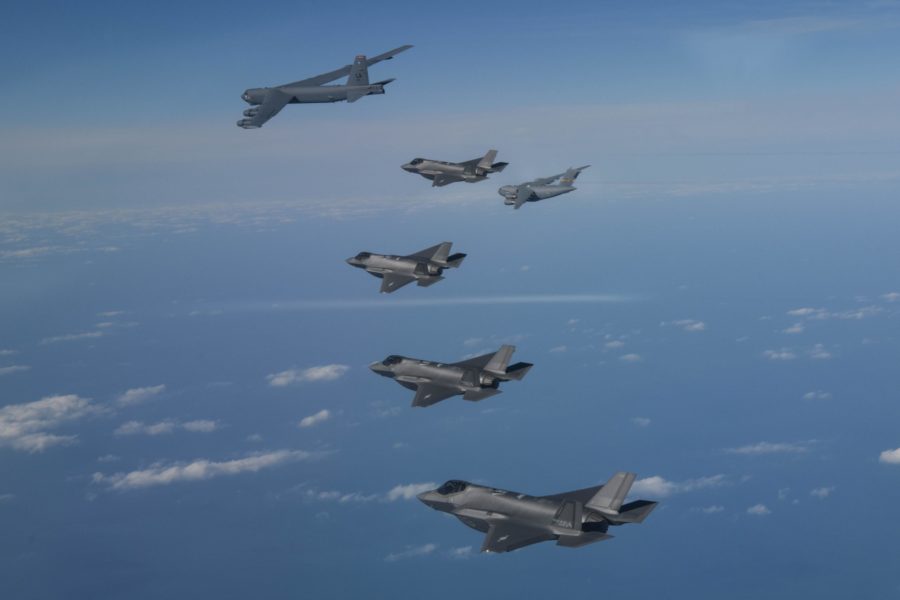An independent, bipartisan commission is recommending the U.S. and South Korea begin “pre-decisional” discussions about what it would take to redeploy tactical nuclear weapons to the region should tensions reach a point where such a move is warranted.
The 14-member Center for Strategic and International Studies’ Commission on the Korean Peninsula, comprised of former diplomats and defense officials, as well as academics, concluded that redeploying nuclear weapons is not necessary under present conditions. But its report and recommendations, released Jan. 19, acknowledge the “perilous landscape” for the U.S.-South Korean alliance.
Members of the panel include retired Army Gen. Vincent K. Brooks, former commander of U.S. Forces Korea; Randall G. Schriver, former Assistant Secretary of Defense for Indo-Pacific security affairs; Richard L. Armitage, former Deputy Secretary of State; and Katrin F. Katz, former director of Korea, Japan, and Oceanic Affairs for the National Security Council.
INorth Korea spate of recent nuclear missile tests have increased tensions on the peninsula, with U.S. aircraft flying show-of-force missions alongside South Korean fighters and, last week, Republic of Korea President Yoon Suk Yeol announcing that his country may be forced to either ask the U.S. to redeploy nuclear arms on the peninsula or to develop nuclear weapons of its own.
Yoon’s comments sparked a wave of debate over nuclear proliferation; a public poll in South Korea suggested growing support for countering the North’s nuclear program with one of its own.
Brooks offered a cautious outlook at a virtual event for the report’s release. “Under the present circumstances, especially given the second purpose of extended deterrence, which is to prevent proliferation,” Brook said, “nuclear weapons on the Korean Peninsula…is not helpful at the present time or needed.”
But as part of a series of recommendations for bolstering extended deterrence, the commission did include “one door that was left open,” Brooks said.
“The allies should consider tabletop planning exercises for the possible redeployment of U.S. nuclear weapons to South Korea,” the recommendation states. “This planning should be explicitly pre-decisional. The timeline and scope of weapons … should be left deliberately ambiguous. Decision-making would be calibrated to shifts in the security environment and the North Korean threat level.”
Planning exercises should consider factors such as storage facilities for nuclear weapons, joint training on nuclear safety and security, and “certifying Korea-based U.S. F-16 units or F-35 replacements for combined exercises and nuclear missions,” the report adds.
The U.S. Air Force today bases A-10s and F-16s at both Osan and Kunsan Air Bases and has not announced plans to replace them with F-35s, but over time, F-35s will supplant those older platforms. The U.S. withdrew its nuclear weapons from the Korean Peninsula in 1991.
Considering logistical steps for supporting nuclear arms in South Korea is necessary to ensure preparedness for all possible contingencies, Katz argued.
“I think it’s somewhat irresponsible to not think about those things and talk about it fully in the abstract,” Katz said. “So I don’t think we should be fearful of talking about the thing itself, and I think there’s a little bit of that right now.”
The commission also recommended the U.S. consider shifting its strategic and nuclear posture in the region, such as whether it would make sense to maintain a “continuous presence of … either U.S. submarines equipped with nuclear cruise missiles or strategic bombers, or investing in infrastructure in South Korea to [support] U.S. dual-capable aircraft.”
The Air Force regularly deploys bombers to the Indo-Pacific through its Bomber Task Forces, typically basing those deploying units in Guam and flying missions to Australia and Japan. Recently, however, B-52 nuclear-capable bombers and a B-1B Lancer flew with South Korean fighters near the peninsula, in response to North Korean missile tests.
The commission also recommended maintaining existing military exercises, expanding cooperation in space “to enhance reconnaissance capabilities,” and providing South Korea direct access to the Space-Based Infrared System for missile warning. The U.S. recently agreed to extend cooperation in Space with Japan, another strong ally in the region.
